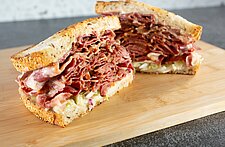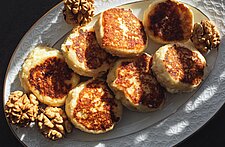 The demand for different flavors and nutrients in food is almost always shifting. As a representative of the food and beverage industry, you know it’s critical to stay on top of the types of products that consumers are wanting. Stepping into the customer’s shoes, you can ask the questions that drive decision-making when faced with a product choice. Of course, it’s important to know what people are eating. But an equally important question is when people are eating. Do people want your product throughout the day, or just for a specific meal?
The demand for different flavors and nutrients in food is almost always shifting. As a representative of the food and beverage industry, you know it’s critical to stay on top of the types of products that consumers are wanting. Stepping into the customer’s shoes, you can ask the questions that drive decision-making when faced with a product choice. Of course, it’s important to know what people are eating. But an equally important question is when people are eating. Do people want your product throughout the day, or just for a specific meal?
In addition to the food itself, the situation affects the demand. Consumers have different priorities in their dietary needs during different eating occasions. We’ve noticed some trends in what people are looking for in breakfast, lunch, and snacks throughout the day.
Nutritional Bounty in Breakfast Foods
Breakfast continues to be many people’s favorite time to eat in a day. Additionally, morning munchers are looking for specific values in their breakfast foods. Whether folks want a healthy start to their day or a powerful energy boost, all the values share a common theme: People want breakfast food that serves a purpose.
The key here is to highlight the functions of specific ingredients. Do the ancient grains meet the needs for daily fiber intake? Does the cereal contain immune-boosting antioxidants? In their breakfast foods, people look for holistic health options that benefit their brains and bodies. Here are some of the key breakfast trends to keep in mind.
Hot Cereal Autumn
A perfect recipe for a healthful energy boost, hot cereal has rocketed in popularity since the pandemic. Oatmeal is the classic, but there’s a cornucopia of wholesome grains that fall into the hot cereal category. Consumers are excited by the diversity of ancient grains, including amaranth, teff, millet, quinoa, and barley. Whether you eat with the sunrise or wait to break your fast until later, hot cereal works for all the popular breakfast times.
There are a couple of reasons that hot cereal is so appealing. Not only does hot cereal offer a rich nutritional profile, but it is also the perfect vessel for indulgent flavors. While energy and health are the top values people seek out in breakfast food, consumers also want food that tastes good.
Consumer Priorities in Cereal
Taste is important, but consumers don’t want to sacrifice health. Though dessert flavors do well for cereals, sugar content is customers’ biggest pain point. The three main factors consumers look for in cereal are:
-
Low sugar content
-
High fiber
-
High protein
If indulgent flavors can be incorporated into a nutritional base, that’s a win-win. Seasonal spice flavors always are a hit, but you can’t go wrong with classics like chocolate chip or toasted almond. Delectable flavors like these pair well with cereal’s nutritional perks. On the packaging, prominently highlight low-sugar and immune-boosting ingredients. Pair enticing flavors with a nutritional plug for the best of both worlds.
Cereal: It’s Not Just for Breakfast
Nutritious, delicious, and convenient, cereal is the perfect breakfast food. So why limit it to breakfast? Studies show that consumers are open to eating hot and cold cereal throughout the day. Advertising cereal for brunch, snacks, or a late-night treat broadens its niche and better reflects how consumers use the products. Many cereal brands are taking the chance to extend their product usage by marketing their product as an after-dinner treat or post-workout snack.
Snacks Throughout the Day
The blending of breakfast foods and snacks is also reflected by the trends in bars and protein shakes. Most people snack between two and three times each day. The reasons people snack vary, but most often people have a snack to give themselves an energy boost, a break from work, or an indulgent treat. As we noted, a bowl of cereal is often enjoyed as a snack at various times of the day. But cereal grains make their way into snacks in other ways too. Cereal bars are the perfect example. The chance to have a sweet treat in the afternoon or the evening motivates many snackers.
As with cereal, people don’t want to think they’re snacking on empty carbs. They want snack food with a nutritional twist. Examples include high-protein brownies, cookies with added fiber, and salted caramel bars made with legume-based flour.
Bars
Bars are a truly multifunctional food, and there are so many opportunities to specialize. They can function as a post-workout snack, a meal replacement, a mid-morning treat, or an afternoon energy boost. The current lunch trends see consumers opting for quick convenience over the traditional Tupperware of leftovers. From a marketing perspective, flavor and protein content are the two primary motivators for consumers. Similar to cereals, people want bars that are delicious dessert flavors but are low in sugar and high in protein and other nutrients. As noted, people are eating more for holistic health goals, not purely physical health. To meet this need, highlight the ingredients that benefit mental and emotional health.
With the demand for an immersive snack experience, bars are getting more complex. With ingredients like Himalayan pink salt or truffle mushrooms, flavors become more nuanced and luxurious. The complexity also comes from texture. Creamy fillings or crunchy layers create a more varied sensory experience. Finally, the appearance of bars can increase their appeal. Many bars have decorative toppings to create a tempting and mouthwatering look.
Related: Ways to achieve a Healthy Lifestyle
Protein Shakes
Similar to the other snack trends, the demand for protein shakes centers around good taste and good nutrition. While people want shakes that taste good, sugar continues to be an obstacle. In picking a protein shake, customers are drawn toward options that have minimal sugar and low carbs.
Consumers are overwhelmed by complicated ingredient lists full of artificial flavors and preservatives. As a result, we’ve seen an increase in product launches that promise shakes with no additives. More minimalist packaging with clear labels sends a message of transparency to consumers. Additionally, protein shake consumers value products without allergens. Specializing in a niche with dairy-free, gluten-free, or plant-based protein shakes can foster a committed customer base.
Indulgent Nutrition
No matter what the meal is, the current trends see products that can fit into multiple different eating occasions. Breakfast foods, snacks, and wholesome desserts overlap, creating more opportunities to market your product.
Subscribe to In-sight to receive articles and reports directly to your inbox, CLICK HERE!





